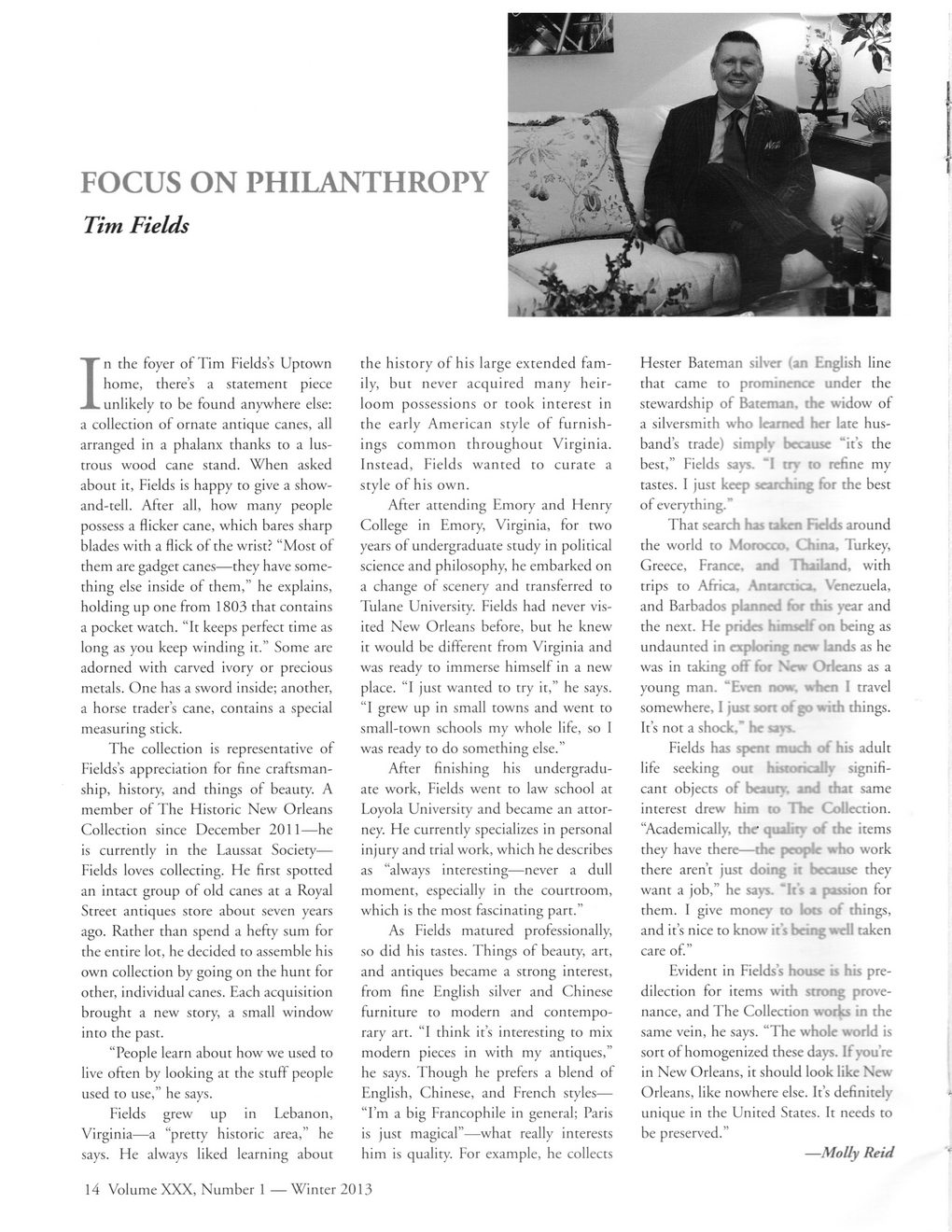This text was obtained via automated optical character recognition.
It has not been edited and may therefore contain several errors.
In the foyer of Tim Fields’s Uptown home, there’s a statement piece unlikely to be found anywhere else: a collection of ornate antique canes, all arranged in a phalanx thanks to a lustrous wood cane stand. When asked about it, Fields is happy to give a show-and-tell. After all, how many people possess a flicker cane, which bares sharp blades with a flick of the wrist? “Most of them are gadget canes—they have something else inside of them,” he explains, holding up one from 1803 that contains a pocket watch. “It keeps perfect time as long as you keep winding it.” Some are adorned with carved ivory or precious metals. One has a sword inside; another, a horse trader’s cane, contains a special measuring stick. The collection is representative of Fields’s appreciation for fine craftsmanship, history, and things of beauty. A member of The Historic New Orleans Collection since December 2011—he is currently in the Laussat Society— Fields loves collecting. He first spotted an intact group of old canes at a Royal Street antiques store about seven years ago. Rather than spend a hefty sum for the entire lot, he decided to assemble his own collection by going on the hunt for other, individual canes. Each acquisition brought a new story, a small window into the past. “People learn about how we used to live often by looking at the stuff people used to use,” he says. Fields grew up in Lebanon, Virginia—a “pretty historic area,” he says. He always liked learning about the history of his large extended family, but never acquired many heirloom possessions or took interest in the early American style of furnishings common throughout Virginia. Instead, Fields wanted to curate a style of his own. After attending Emory and Henry College in Emory, Virginia, for two years of undergraduate study in political science and philosophy, he embarked on a change of scenery and transferred to Tulane University. Fields had never visited New Orleans before, but he knew it would be different from Virginia and was ready to immerse himself in a new place. “I just wanted to try it,” he says. “I grew up in small towns and went to small-town schools my whole life, so I was ready to do something else.” After finishing his undergraduate work, Fields went to law school at Loyola University and became an attorney. He currently specializes in personal injury and trial work, which he describes as “always interesting—never a dull moment, especially in the courtroom, which is the most fascinating part.” As Fields matured professionally, so did his tastes. Things of beauty, art, and antiques became a strong interest, from fine English silver and Chinese furniture to modern and contemporary art. “I think it’s interesting to mix modern pieces in with my antiques,” he says. Though he prefers a blend of English, Chinese, and French styles— “I’m a big Francophile in general; Paris is just magical”—what really interests him is quality. For example, he collects Hester Bateman silver (an English line that came to prominence under the stewardship of Bateman, the widow of a silversmith who learned her late husband’s trade) simply because “it’s the best,” Fields says. "I try to refine my tastes. I just keep searching for the best of everything.” That search has t«!vn Fields around the world to Morocco. China, Turkey, Greece, France, and Thailand, with trips to Africa, Antarctica, Venezuela, and Barbados planned for this year and the next. He pride* on being as undaunted in exploring new lands as he was in taking off for New Orleans as a young man. “Even now. when I travel somewhere, I just son of go with things. It’s not a shock,’" he sarv Fields has spent much of his adult life seeking out histori^lh' significant objects of beauty, and that same interest drew him to The Collection. “Academically, the quallr.' of the items they have there—the people who work there aren’t just doing it because they want a job,” he says. “Its a passion for them. I give money to loo of things, and it’s nice to know it’s being well taken care of.” Evident in Fields’s house is his predilection for items with strong provenance, and The Collection works in the same vein, he says. “The whole world is sort of homogenized these days. If you’re in New Orleans, it should look like New Orleans, like nowhere else. It’s definitely unique in the United States. It needs to be preserved.” —Molly Reid 14 Volume XXX, Number 1 — Winter 2013

New Orleans Quarterly 2013 Winter (15)